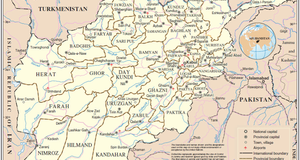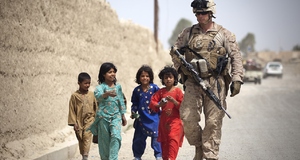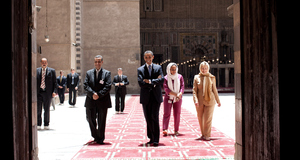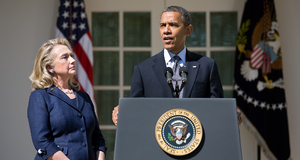The Obama PresidencyZarb-e-Azb: The Obama Administration's Response to the Haqqani Network and the Relationship with PakistanThe Obama Administration's Response to HaqqaniThe United States is currently fighting the Network with counter-insurgency tactics. However, the usage of Pakistani military to conduct combat operations against the Network is an ineffective and foolish endeavor considering the Haqqani’s relationship with the Pakistani military. The Combatting Terrorism Center at West Point published a number of documents through the Harmony system pointing at correspondence between Haqqani leadership and the military in which a number of military officers were offering their skills to join the jihad with the Haqqanis28. While Pakistan has recently shown efforts to combat the Network with Operation Zarb-e-Azb, one wonders about the effectiveness of a campaign against an enemy with so many connections to the military and government. Numerous sources including the Afghan National Directorate of Security (NDS) indicated on July 23, 2013 that two weeks prior to the commencement of Operation Zarb-e-Azb, Pakistani leaders moved key Haqqani commanders to strategic points in Kurram, Quetta, Karachi and Islamabad. Establishing these commanders, especially in Kurram keeps the Haqqanis strategically close to the Afghan border while sparing them from the military offensive in Waziristan. The NDS continued to state that while Pakistan reported success from the offensive, it did not affect any of the targeted terrorist networks including the Haqqani Network. The Pakistani military had moved the Haqqanis to Kurram in the past as well29. In July 2011, Operation Koh-e-Sufair sought to put down an anti-Shia rebellion, and Pakistani military transported the Haqqanis to assist with quelling the rebellion as well as to establish the Haqqani influence in a region other than Waziristan30. Upon launching Operation Zarb-e-Azb, the Haqqanis were not a publicly acknowledged target of the offensive. Diplomats in Islamabad countered the ideas that the Operation had any effect, while Pakistani authorities claimed to have killed 910 militants in roughly 4 months of the operation. Additionally, the Pakistanis claimed to have cleared a 90km long road leading to Miramshah as well as twenty-seven improvised explosive device factories and one ammunition factory.The vast majority of the fighting was conducting in North Waziristan, accounting for roughly half of the Pakistani military’s 82 deaths, and only 23 coming from the rest of the FATA. The number of militants killed is an optimistic projection, as the terrain is incredibly difficult, and North Waziristan as the homebase of the Haqqanis, Taliban and others. The United States and the international community as a whole largely pressured the Pakistanis into initiating the offensive due to waning public support for lack of Pakistani counter-terror operations and growing resentment for Pakistani sheltering of terror organizations. The international distrust of Pakistani military operations results from the recognition of the lasting Pakistani relationship with the Haqqani network and other terror organizations. Admiral Mike Mullen, in speaking with a Senate Panel stated that the Haqqanis act as a “veritable arm of the ISI”31. The White House practically affirmed those words, stating that, while it would not be the language they would use, the statement is not necessarily untrue. While no one except the ISI and Haqqanis can detail how much influence the Pakistanis have over the Haqqani Network, it would be foolish not to acknowledge the existence of that influence. The RAND Corporation spent several years studying the relationship, discovering funding, intelligence and tactical aid to the Haqqanis. This is supported by other American officials who pointed out that a number of strikes against bin Laden and the Haqqanis killed ISI agents in many of those cases32. United States aid to Pakistan, specifically military aid, is subject to Pakistan reaching certain benchmarks, however, these assistance benchmarks are usually not adhered to. This is partially the result of the strong position that Pakistan holds in the region, most NATO supply lines run through Pakistan which could easily be cutoff3334. Additionally, as U.S. military trainers were expelled from Pakistan, they could do the same with intelligence officials, creating a vacuum of intelligence for the CIA and other intelligence agencies. Limiting ISI and Pakistani military involvement in the affairs of terrorist organizations is critical to the stability of Pakistan and Afghanistan35. President Musharraf, President of Pakistan from 2001-2008 eliminated a large number of high-ranking Islamist Pakistani military officers, eliminating some influence of terrorist sympathizers on Pakistani military. In 2011, the United States deferred nearly $800 million in counter-terrorism funding to Pakistan as a result of not meeting counterterrorism benchmarks3637. However, this does not address the true problems that Pakistan currently needs to solve. Auditing the funding on behalf of the United States would ensure that the funds are not going to leaders, the military industrial complex or beneficiaries that do not support the mission of the United States. Currently one of the most corrupt countries in the world, there is not enough transparency with the huge sums going to support Pakistani counter-terror and military campaigns. For all the United States knows and the Pakistani relationship with the Haqqanis and other terror organizations, foreign aid could be funding the very enemies the United States is fighting. However, cutting off all aid to Pakistan is more dangerous than continuing the pipeline. Cutting off all funding, military, humanitarian and developmental aid would destabilize the country, likely resulting in the downfall of a significantly weakened Pakistani state38. The prospect of a deposed, nuclear regime is a terrifying prospect, especially one with such an enduring relationship with recognized terrorist organizations. Currently, U.S. funding totals over $4.4 billion per year, nearly 68% of these funds are dedicated to security assistance, and 43% dedicated to funding Pakistani costs incurred through operations along the Pakistani-Afghan border39. The 43% dedicated to these operations are designated as Coalition Support Funds, largely a gray area when it comes to accounting for costs and auditing the funds given to the Pakistani state40. The benchmarks established with each appropriation, such as crackdowns on groups like the Haqqanis and Lashkar-e-Taiba are usually waived, and the model of the Coalition Support Fund leaves many questions as to how U.S. funds are being spent. UN blacklist of the Haqqanis require all UN member states to actively combat the groups when operating in their borders, as well as asset freezing, travel bans, and arms embargos41. The United Nations Security Council finally declared the Haqqanis a blacklisted organization in November 2012 after the U.S. Department of State declared the group a foreign terrorist organization in September 201242. While the United States and United Nations had named a number of Specially Designated Global Terrorists such as Sirajuddin, Qari Zakir (commander of Haqqani suicide operations) and a number of other Haqqani and Haqqani related Taliban officials. The declaration of the United Nations comes more than ten years after the Haqqanis first begin targeting foreign troops in Afghanistan43. The delay in designating the Haqqanis a terrorist organization can be attributed to a number of reasons. Pakistani support for United States influence in Pakistani affairs is at an all- time low (not that it was high to start with), making the international condemnation of a veritable arm of the Pakistani government even more controversial. The issues surrounding elimination and deferment of foreign aid to Pakistan is also at play in this scenario. Maintaining a strong presence in Pakistan for the elimination of insurgent threats while still sustaining some level of diplomatic relations with Pakistan is a fine line to walk. This extends to both the Pakistani government as well as the Haqqanis. The amount of intelligence available to prove Haqqani operations in Northern Waziristan is massive. On numerous occasions, United States Special Forces and CIA operatives have been prepared to launch raids on Haqqani leadership and bases but have been called off due to Pakistani military tips to the Haqqanis or to fear of retaliation on behalf of Pakistan or the Haqqanis. This not only speaks to the deadly abilities of Haqqani operatives but yet again to the relationship between the Pakistani government and the Haqqanis. One of the major reasons the CIA especially has been leery of raiding Haqqani camps and madrassas was the fear of retaliation. The Haqqanis have pioneered numerous tactics and innovative technology that are now commonplace in militant jihad44. Innovating the use of suicide bombers in Afghanistan, the Haqqanis have distinguished their targets as high profile and symbolic with sophisticated tactics. Targets often include military targets such as the ISAF headquarters in Kabul, the Indian Embassy in Kabul, sports matches and government buildings45. The Haqqanis were also implicated in the suicide bombing of a CIA base in eastern Afghanistan, Camp Chapman46. Killing seven CIA operatives, the Haqqanis were responsible for the most deadly single day for the CIA in decades. The ability of the Haqqanis to operate with near impunity within the borders of Pakistan was countered with the advent of weaponized drones, however, adapting tactics makes the leaders more and more difficult to locate. The effectiveness of the military and counter-insurgency operations is also a matter of culture. The Pashtun people are vehemently anti-government; they are incredibly leery of centralized services in contrast to the lowland Pakistani and Afghani47. This fiercely independent nature has made the highlands notoriously difficult to govern; neither Afghanistan, Pakistan, Britain nor any other power has successfully integrated Pashtun into a centralized government48. Thus, Afghanistan and Pakistan have largely left the tribal regions autonomous and under the control of the various tribes and Shuras. Consequently, not only are the insurgent groups actively fighting Pakistan’s army, but locals are extremely circumspect of the government’s actions. Local support has also dwindled due to the increase in drone activity and strikes against both insurgent and civilian targets. Drone strikes have been called the single most effective recruiting tool for insurgents, and the scope of strikes has changed dramatically with the Obama Administration. First used in Pakistan in 2004, international public support for drone strikes has dwindled to nearly nothing. The issue of drone strikes has divided Pakistan into groups of those who support or disagree with the Taliban and militant jihadists, however, overall support has become more blurred with the more frequent incursion of U.S. drone, civilian deaths and infringements on Pakistani sovereignty49. The Bush Administration used drone strikes sparingly for a total of 48 strikes confirmed by reputable news sources, and primarily concentrated on al-Qaeda targets in Khyber Pakhtunkhwa province. Barack Obama in contrast has focused on Taliban and Haqqani related targets for a total of 338 confirmed DOD strikes in the FATA, especially Waziristan 5051. The large number of civilian deaths associated with these drone strikes has led to even more distrust in large centralized government, especially that of and supported by the west. While modern warfare tactics such as drone strikes and special operations raids are meant to limit collateral damage and risk to ISAF troops, it is still the single most useful tactic for jihadist recruitment. While continued military action would eliminate more and more insurgents, it has not targeted the reasons for insurgent recruitment. These soldiers are joining the cause as a result of occupation by western powers, poverty, illiteracy, famine, and countless other issues that are not conquered by the ISAF teams. Pakistan has suffered great criticism for simply concentrating on battling those insurgents who already exist and not working on cutting off the pipeline of the insurgents or facing the causes of joining the jihad.Continued on Next Page » Suggested Reading from Inquiries Journal
Inquiries Journal provides undergraduate and graduate students around the world a platform for the wide dissemination of academic work over a range of core disciplines. Representing the work of students from hundreds of institutions around the globe, Inquiries Journal's large database of academic articles is completely free. Learn more | Blog | Submit Latest in International Affairs |


















